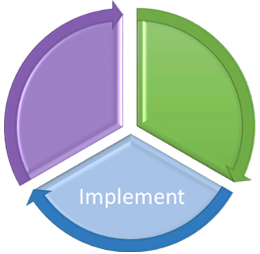Monitor & Report Key Indicators
Contact Us
If you have any questions or would like additional informaion, please contact the Program Planning & Evaluation team: ppe@mlhu.on.ca

The IMPLEMENT phase includes 5 stages. Below is an overview of each. Each stage has a corresponding stage guide that can be be opened by selecting the phase's buttons or the title of the brief description.
Monitor & Report Key Indicators
If you have any questions or would like additional informaion, please contact the Program Planning & Evaluation team: ppe@mlhu.on.ca

In this stage, you will develop a program description and/or logic model for your program that shows the relationships between the resources you have, the activities you intend to do and the results you hope to achieve. This will become your road map for the program. Developing your program description and/or logic model will help you take what you learned in the PLAN phase and develop an actionable program. You need this foundational information to guide you through the IMPLEMENT and EVALUATE phases.
| Program Description | Program Logic Model |
| Intervention Description | Intervention Logic Model |
In this stage, you will identify and prioritize key indicators and develop a plan for collecting data about your program. These indicators can then be used for internal (e.g. Planning & Budget Template, Balanced Scorecard) and Ministry (e.g. Annual Service Plans, Accountability Agreements) reporting. Identifying key indicators provides a way to monitor how your program is doing and identify areas for improvement. Data collection and analysis strategies need to be set up from the beginning to ensure you are collecting the right information and you have a solid plan for how it will be analyzed.
| New Data Collection | Routine Monitoring & Reporting |
| Indicator Development |
In this stage, you will develop a work plan that identifies concrete action items for implementing your program. You will start by gathering the specific support you need from others and set timelines for tasks. Clearly outlining your implementation steps and timelines can ensure others are ready to complete work plan activities when needed.
| Work Plan | Program Logic Model |
| Budget | Intervention Logic Model |
| Program Description | Indicator Development |
| Intervention Description |
In this stage, you will begin implementing your program. It will be important to gather feedback early on to see how your new processes are working. Early adjustments to your program using the feedback you gathered can improve how you deliver your program and support the change(s) you want to make.
| Work Plan |
In this stage, you will review and report on the key program indicators previously established. Monitoring key indicators is an important step in delivering effective public health programs. Routine monitoring and reporting of key indicators can identify program areas that are working well, areas where processes can be improved (continuous quality improvement (CQI)) and/or areas where an evaluation is needed.
| Work Plan | Routine Monitoring and Reporting |
| Knowledge Exchange Plan |